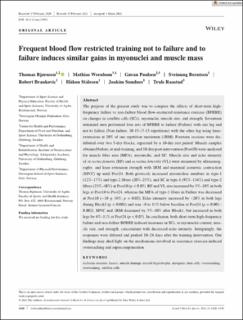Frequent blood flow restricted training not to failure and to failure induces similar gains in myonuclei and muscle mass
| dc.contributor.author | Bjørnsen, Thomas | |
| dc.contributor.author | Wernbom, Mathias | |
| dc.contributor.author | Paulsen, Gøran | |
| dc.contributor.author | Berntsen, Sveinung | |
| dc.contributor.author | Brankovic, Robert | |
| dc.contributor.author | Stålesen, Håkon | |
| dc.contributor.author | Sundnes, Joakim | |
| dc.contributor.author | Raastad, Truls | |
| dc.date.accessioned | 2021-09-22T15:24:25Z | |
| dc.date.available | 2021-09-22T15:24:25Z | |
| dc.date.created | 2021-08-06T11:24:02Z | |
| dc.date.issued | 2021 | |
| dc.identifier.citation | Scandinavian Journal of Medicine & Science in Sports. 2021, 31(7), 1420-1439. | en_US |
| dc.identifier.issn | 0905-7188 | |
| dc.identifier.uri | https://hdl.handle.net/11250/2780430 | |
| dc.description | This is an open access article under the terms of the Creative Commons Attribution License, which permits use, distribution and reproduction in any medium, provided the original work is properly cited. | en_US |
| dc.description.abstract | The purpose of the present study was to compare the effects of short-term high-frequency failure vs non-failure blood flow–restricted resistance exercise (BFRRE) on changes in satellite cells (SCs), myonuclei, muscle size, and strength. Seventeen untrained men performed four sets of BFRRE to failure (Failure) with one leg and not to failure (Non-failure; 30-15-15-15 repetitions) with the other leg using knee-extensions at 20% of one repetition maximum (1RM). Fourteen sessions were distributed over two 5-day blocks, separated by a 10-day rest period. Muscle samples obtained before, at mid-training, and 10-day post-intervention (Post10) were analyzed for muscle fiber area (MFA), myonuclei, and SC. Muscle size and echo intensity of m.rectus femoris (RF) and m.vastus lateralis (VL) were measured by ultrasonography, and knee extension strength with 1RM and maximal isometric contraction (MVC) up until Post24. Both protocols increased myonuclear numbers in type-1 (12%–17%) and type-2 fibers (20%–23%), and SC in type-1 (92%–134%) and type-2 fibers (23%–48%) at Post10 (p < 0.05). RF and VL size increased by 5%–10% in both legs at Post10 to Post24, whereas the MFA of type-1 fibers in Failure was decreased at Post10 (−10 ± 16%; p = 0.02). Echo intensity increased by 20% in both legs during Block1 (p < 0.001) and was 8 to 11% below baseline at Post24 (p = 0.001–0.002). MVC and 1RM decreased by 5%–10% after Block1, but increased in both legs by 6%–11% at Post24 (p < 0.05). In conclusion, both short-term high-frequency failure and non-failure BFRRE induced increases in SCs, in myonuclei content, muscle size, and strength, concomitant with decreased echo intensity. Intriguingly, the responses were delayed and peaked 10–24 days after the training intervention. Our findings may shed light on the mechanisms involved in resistance exercise-induced overreaching and supercompensation. | en_US |
| dc.language.iso | eng | en_US |
| dc.subject | ischemic exercise | en_US |
| dc.subject | kaatsu | en_US |
| dc.subject | muscle damage | en_US |
| dc.subject | muscle hypertrophy | en_US |
| dc.subject | myogenic stem cells | en_US |
| dc.subject | overreaching | en_US |
| dc.subject | overtraining | en_US |
| dc.subject | satellite cells | en_US |
| dc.title | Frequent blood flow restricted training not to failure and to failure induces similar gains in myonuclei and muscle mass | en_US |
| dc.type | Peer reviewed | en_US |
| dc.type | Journal article | en_US |
| dc.description.version | publishedVersion | en_US |
| dc.rights.holder | © 2021 The Authors | en_US |
| dc.source.pagenumber | 1420-1439 | en_US |
| dc.source.volume | 31 | en_US |
| dc.source.journal | Scandinavian Journal of Medicine & Science in Sports | en_US |
| dc.source.issue | 7 | en_US |
| dc.identifier.doi | 10.1111/sms.13952 | |
| dc.identifier.cristin | 1924349 | |
| dc.description.localcode | Institutt for fysisk prestasjonsevne / Department of Physical Performance | en_US |
| cristin.ispublished | true | |
| cristin.fulltext | original | |
| cristin.qualitycode | 2 |
Tilhørende fil(er)
Denne innførselen finnes i følgende samling(er)
-
Artikler / Articles [2096]
-
Publikasjoner fra Cristin [1084]
